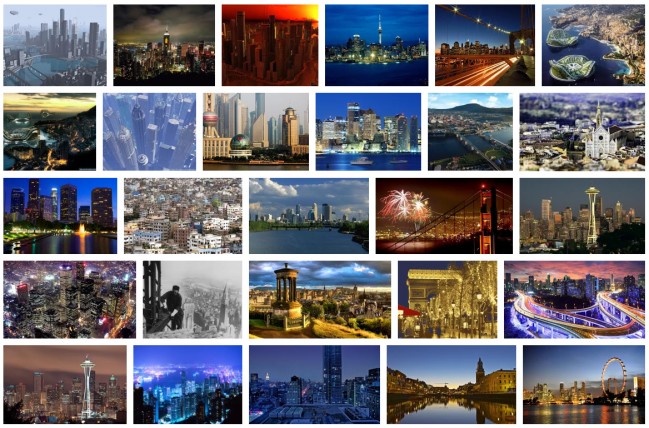Big data keeps getting bigger and computers keep getting faster. Some theorists believe that the universe is a giant computer or a computer simulation; that principles of information science govern the cosmos. While this notion is one of the most recent radical ideas to explain our existence, there is no doubt that information is our future. Data surrounds us, we are becoming data-points and our cities are our information-rich databases.
[div class=attrib]From the Economist:[end-div]
IN 1995 GEORGE GILDER, an American writer, declared that “cities are leftover baggage from the industrial era.” Electronic communications would become so easy and universal that people and businesses would have no need to be near one another. Humanity, Mr Gilder thought, was “headed for the death of cities”.
It hasn’t turned out that way. People are still flocking to cities, especially in developing countries. Cisco’s Mr Elfrink reckons that in the next decade 100 cities, mainly in Asia, will reach a population of more than 1m. In rich countries, to be sure, some cities are sad shadows of their old selves (Detroit, New Orleans), but plenty are thriving. In Silicon Valley and the newer tech hubs what Edward Glaeser, a Harvard economist, calls “the urban ability to create collaborative brilliance” is alive and well.
Cheap and easy electronic communication has probably helped rather than hindered this. First, connectivity is usually better in cities than in the countryside, because it is more lucrative to build telecoms networks for dense populations than for sparse ones. Second, electronic chatter may reinforce rather than replace the face-to-face kind. In his 2011 book, “Triumph of the City”, Mr Glaeser theorises that this may be an example of what economists call “Jevons’s paradox”. In the 19th century the invention of more efficient steam engines boosted rather than cut the consumption of coal, because they made energy cheaper across the board. In the same way, cheap electronic communication may have made modern economies more “relationship-intensive”, requiring more contact of all kinds.
Recent research by Carlo Ratti, director of the SENSEable City Laboratory at the Massachusetts Institute of Technology, and colleagues, suggests there is something to this. The study, based on the geographical pattern of 1m mobile-phone calls in Portugal, found that calls between phones far apart (a first contact, perhaps) are often followed by a flurry within a small area (just before a meeting).
Data deluge
A third factor is becoming increasingly important: the production of huge quantities of data by connected devices, including smartphones. These are densely concentrated in cities, because that is where the people, machines, buildings and infrastructures that carry and contain them are packed together. They are turning cities into vast data factories. “That kind of merger between physical and digital environments presents an opportunity for us to think about the city almost like a computer in the open air,” says Assaf Biderman of the SENSEable lab. As those data are collected and analysed, and the results are recycled into urban life, they may turn cities into even more productive and attractive places.
Some of these “open-air computers” are being designed from scratch, most of them in Asia. At Songdo, a South Korean city built on reclaimed land, Cisco has fitted every home and business with video screens and supplied clever systems to manage transport and the use of energy and water. But most cities are stuck with the infrastructure they have, at least in the short term. Exploiting the data they generate gives them a chance to upgrade it. Potholes in Boston, for instance, are reported automatically if the drivers of the cars that hit them have an app called Street Bump on their smartphones. And, particularly in poorer countries, places without a well-planned infrastructure have the chance of a leap forward. Researchers from the SENSEable lab have been working with informal waste-collecting co-operatives in São Paulo whose members sift the city’s rubbish for things to sell or recycle. By attaching tags to the trash, the researchers have been able to help the co-operatives work out the best routes through the city so they can raise more money and save time and expense.
Exploiting data may also mean fewer traffic jams. A few years ago Alexandre Bayen, of the University of California, Berkeley, and his colleagues ran a project (with Nokia, then the leader of the mobile-phone world) to collect signals from participating drivers’ smartphones, showing where the busiest roads were, and feed the information back to the phones, with congested routes glowing red. These days this feature is common on smartphones. Mr Bayen’s group and IBM Research are now moving on to controlling traffic and thus easing jams rather than just telling drivers about them. Within the next three years the team is due to build a prototype traffic-management system for California’s Department of Transportation.
Cleverer cars should help, too, by communicating with each other and warning drivers of unexpected changes in road conditions. Eventually they may not even have drivers at all. And thanks to all those data they may be cleaner, too. At the Fraunhofer FOKUS Institute in Berlin, Ilja Radusch and his colleagues show how hybrid cars can be automatically instructed to switch from petrol to electric power if local air quality is poor, say, or if they are going past a school.
[div class=attrib]Read the entire article after the jump.[end-div]
[div class=attrib]Images of cities courtesy of Google search.[end-div]

